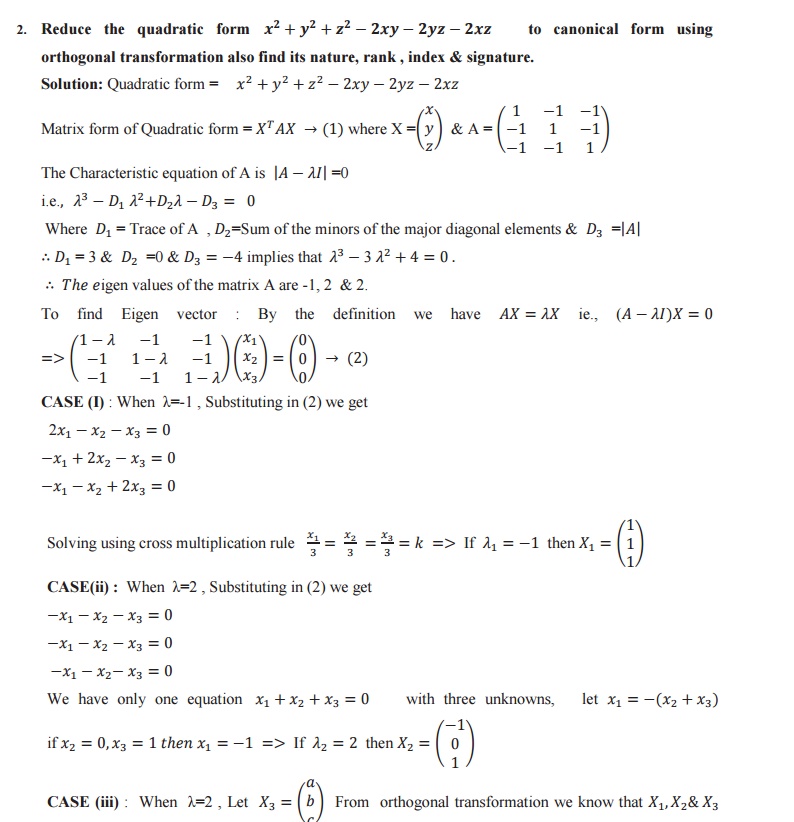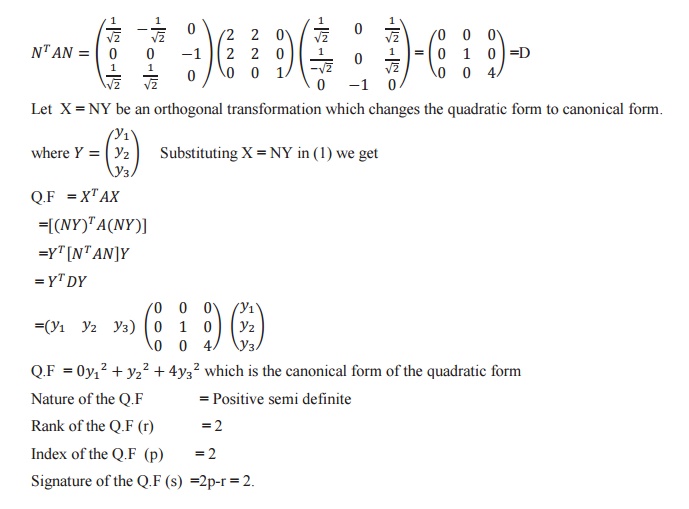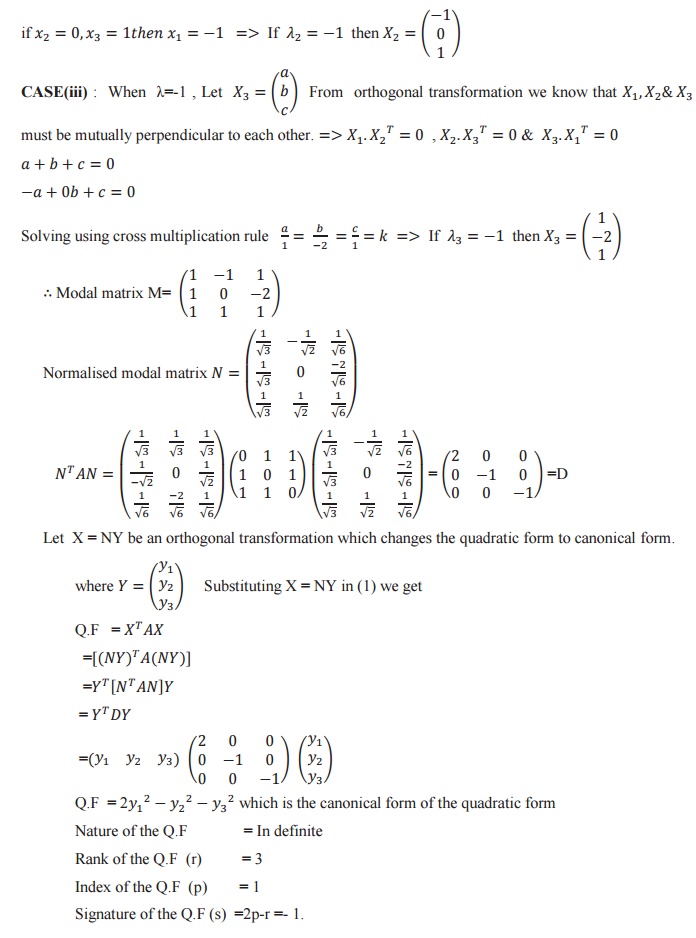Chapter: mathematics : Matrix
Matrix
MATRIX
· CHARACTERISTIC EQUATION
· EIGEN VALUE
· EIGEN VECTOR
· LINEARLY DEPENDENT AND INDEPENDENT EIGEN VECTOR
· PROPERTIES OF EIGEN VALUES AND EIGEN VECTORS:
· CAYLEY HAMILTON THEOREM:
· DIAGONALISATION OF A MATRIX
· DIAGONALISATION BY ORTHOGONAL
· TRANSFORMATION OR ORTHOGONAL REDUCTION
· QUADRATIC FORMS
· NATURE OF QUADRATIC FORMS:
· RULES FOR FINDING NATURE OF QUADRATIC FORM USING PRINCIPAL SUBDETERMINANTS:
CHARACTERISTIC EQUATION
Let ‘A’ be a given matrix. Let λ be a scalar. The equation det [A- λ I]=0 is called the characteristic equation of the matrix A.
1. Find the Characteristic equation of A = [(1 4) (2 3)]

EIGEN VALUE
The values of λ obtained from the characteristic equation |A- λ I|=0 are called the Eigen values of A.
EIGEN VECTOR
Let A be a square matrix of order ‘n’ and λ be a scalar, X be a non- zero column vector such that AX = λX.

LINEARLY DEPENDENT AND INDEPENDENT EIGEN VECTOR
Let ‘A’ be the matrix whose columns are eigen vectors.
(i) If |A|=0 then the eigen vectors are linearly dependent.
(ii) If |A|=!0 then the eigen vectors are linearly independent.
1. Find the eigen values and eigen vectors of

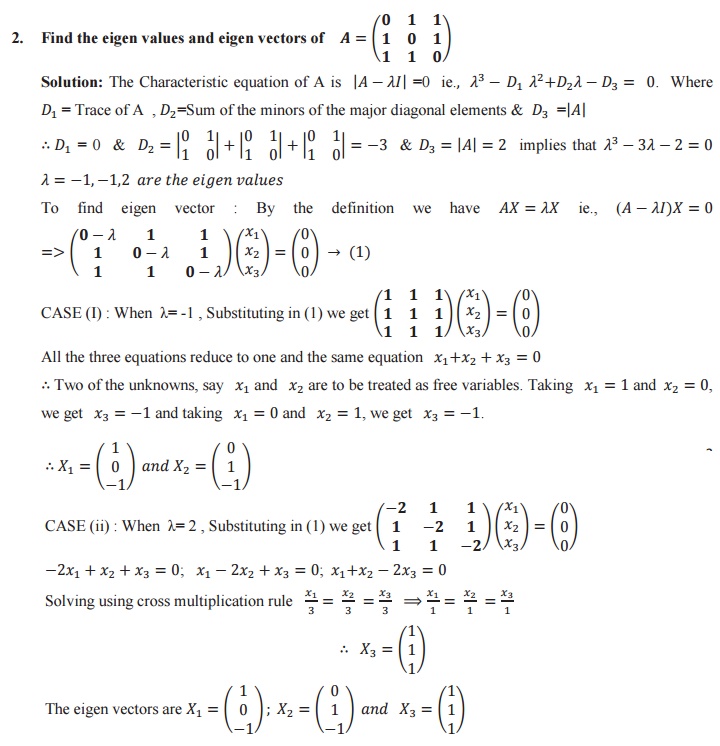
Though two of the Eigen values are equal, the Eigen vectors are X1,X2,X3 are linearly independent.
NOTE:
(i) The Eigen vector corresponding to an Eigen value is not unique.
(ii) If all the Eigen values of a matrix are distinct, then the corresponding Eigen vectors are linearly independent.
(iii) If two or more Eigen values are equal, then the Eigen vectors may be linearly independent or linearly dependent.
PROPERTIES OF EIGEN VALUES AND EIGEN VECTORS:
Property 1: (I) The sum of the Eigen values of a matrix is equal to the sum of the elements of the principal diagonal (trace of the matrix). i.e., λ1+ λ2+ λ3=a11+a22+a33
(ii)The product of the Eigen values of a matrix is equal to the determinant of the matrix. i.e., λ1 λ2 λ3=|A|
Property 2: A square matrix A and its transpose ܣ have the same Eigen values.
Property 3: The characteristic roots of a triangular matrix are just the diagonal elements of the matrix.
Property 4: If λ is an Eigen value of a matrix A, then 1/ λ, (λ=!0) is the Eigen value of A-1
Property 5: If λ is an Eigen value of an orthogonal matrix A, then 1/ λ, (λ=!0) is also its Eigen value.

Property 9: The Eigen values of a real symmetric matrix are real numbers.
Property 10: The Eigen vectors corresponding to distinct Eigen values of a real symmetric matrix are orthogonal.
Property 11: The similar matrices have same Eigen values.
Property 12: Eigen vectors of a symmetric matrix corresponding to different Eigen values are orthogonal.
Property 13: If A and B are nxn matrices and B is a non singular matrix then A and B-1AB have same Eigen values.
Property 14: Two Eigen vectors X1 and X2 are called orthogonal vectors if X1TX2=0

Note: The absolute value of a determinant (|detA|) is the product of the absolute values of the eigen values of matrix A.
c = 0 is an eigen value of A if A is a singular (noninvertible) matrix
· If A is a n x n triangular matrix (upper triangular, lower triangular) or diagonal matrix, the eigen values of A are the diagonal entries of A.
· A and its transpose matrix have same eigen values.
· Eigen values of a symmetric matrix are all real.
· Eigen vectors of a symmetric matrix are orthogonal, but only for distinct eigen values.
· The dominant or principal Eigen vector of a matrix is an eigen vector corresponding to the Eigen value of largest magnitude (for real numbers, largest absolute value) of that matrix.
· For a transition matrix, the dominant Eigen value is always 1.
· The smallest Eigen value of matrix A is the same as the inverse (reciprocal) of the largest eigen value of A-1; i.e. of the inverse of A.
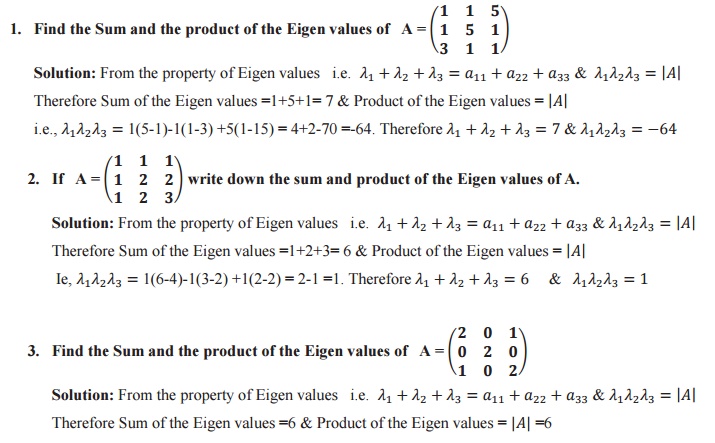




CAYLEY HAMILTON THEOREM:
Every square matrix satisfies its own characteristic equation.

1. If A is non singular matrix then we can get A-1, using this theorem

2. Higher positive integral powers of A can be computed

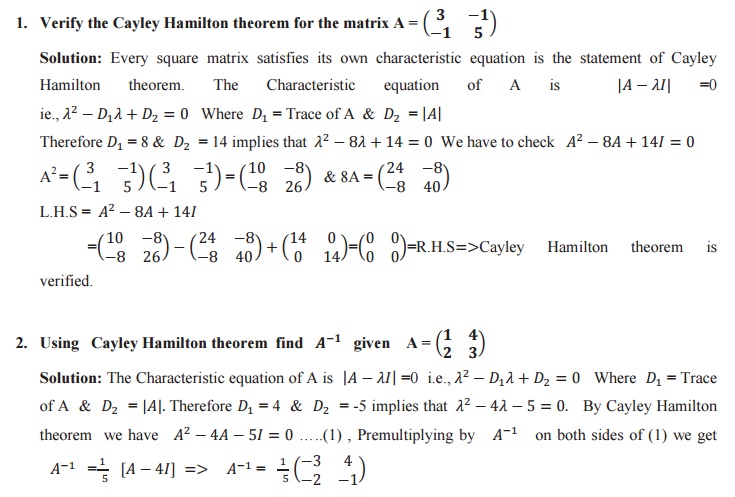


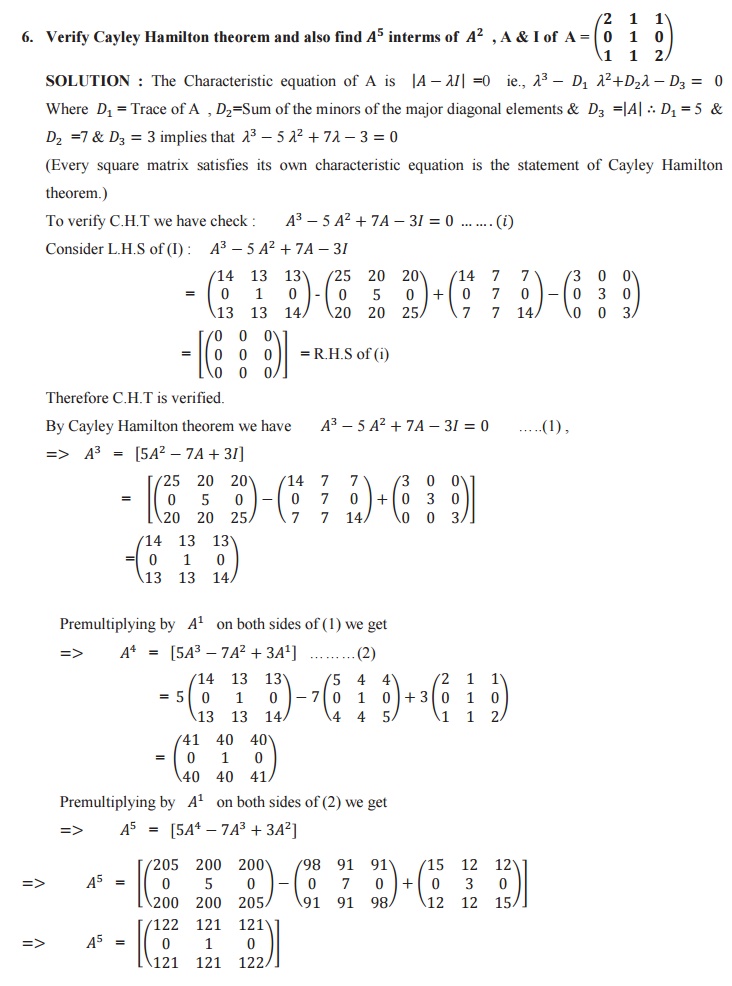


DIAGONALISATION OF A MATRIX
The process of finding a matrix M such that M-1AM=D ,where D is a diagonal matrix, if called diagonalisation of the Matrix A
Note Ak=MDkM-1
DIAGONALISATION BY ORTHOGONAL
TRANSFORMATION OR ORTHOGONAL REDUCTION
If A is a real symmetric matrix, then the Eigen vectors of A will be not only linearly independent but also pair wise orthogonal. If we normalize each eigen vector Xr i.e. divide each element of Xr by the square root of the sum of the square\s of all the elements of Xr and use the normalized Eigen vectors of A to form the normalized modal matrix N, then it can be proved that N is an orthogonal matrix. By a property of orthogonal matrix, N-1= NT.
The similarity transformation M-1AM=D takes the form NTAN=D
Transforming A into D by means of the transformation NTAN=D is known as orthogonal transformation or orthogonal reduction.
NOTE:- Diagonalisation by orthogonal transformation is possible only for a real symmetric matrix.






QUADRATIC FORMS
A homogeneous polynomial of the second degree in any number of variables is called a quadratic form.
For example, x12+2x22-3x32+5x1x2-6x1x3+4x2x3 is a quadratic form in three variables.
The symmetric matrix

is called the matrix of the quadratic form Q.
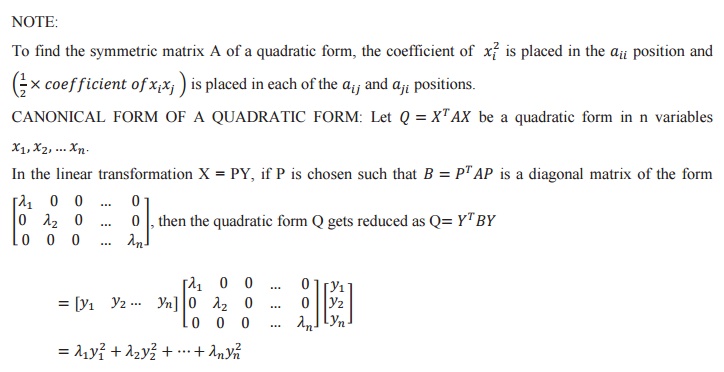
This form of Q is called the sum of the squares form of Q or the canonical form of Q.
NATURE OF QUADRATIC FORMS:
Rank: When the quadratic form is reduced to the canonical form it contains only r terms which is the rank of A.
Index: The number of positive terms in the canonical form is called the index (p) of the quadratic form.
Signature: The difference between the number of positive and negative terms is called signature (s) of the quadratic form [s = 2p-r].
The quadratic form Q=XTAX in n variables is said to be
(i) Positive definite: If r = n and p = n or if all the Eigen values of A are positive.
(ii) Positive semi definite: If r < n and p = r or if all the Eigen values of A>=0 and atleast one Eigen value is zero.
(iii) Negative definite: If r = n and p = 0 or if all the Eigen values of A are negative.
(iv) Negative semi definite: If r < n and p = 0 or if all the Eigen values of A<=0 and atleast one Eigen value is zero.
(v) Indefinite: In all other cases or if A has positive as well as negative Eigen values.
RULES FOR FINDING NATURE OF QUADRATIC FORM USING PRINCIPAL SUBDETERMINANTS:
In this method we can determine the nature of the quadratic form without reducing it to the canonical form. Let A be a square matrix of order n.

Here D1,D2,D3 … … … … Dn are called the principal subdeterminants of A. From D1,D2,D3 … … … … Dn , the nature of the quadratic form can be determined.
1. A Q.F is positive definite if D1,D2,D3 … … … … Dn are all positive i.e., Dn>0 for all n.
2. A Q.F is negative definite if D1,D3,D5 … are all negative and D2,D4,D6 … are all positive i.e.,(-1)n Dn>0 for all n.
3. A Q.F is positive semi- definite if Dn>=0 and atleast one Di=0.
4. A Q.F is negative semi- definite if (-1)nDn >=0 and atleast one Di=0.
5. A Q.F is indefinite in all other cases.

